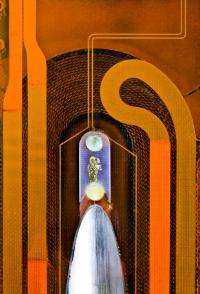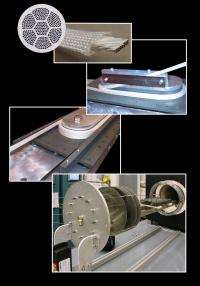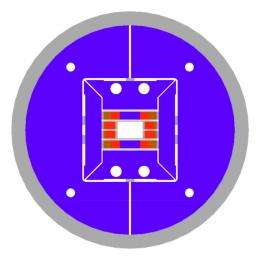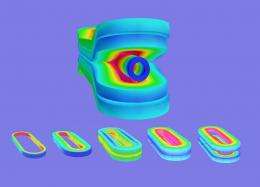Superconductors face the future

Futuristic ideas for the use of superconductors, materials that allow electric current to flow without resistance, are myriad: long-distance, low-voltage electric grids with no transmission loss; fast, magnetically levitated trains; ultra-high-speed supercomputers; superefficient motors and generators; inexhaustible fusion energy - and many others, some in the experimental or demonstration stages.
But superconductors, especially superconducting electromagnets, have been around for a long time. Indeed the first large-scale application of superconductivity was in particle-physics accelerators, where strong magnetic fields steer beams of charged particles toward high-energy collision points.
Accelerators created the superconductor industry, and superconducting magnets have become the natural choice for any application where strong magnetic fields are needed - for magnetic resonance imaging (MRI) in hospitals, for example, or for magnetic separation of minerals in industry. Other scientific uses are numerous, from nuclear magnetic resonance to ion sources for cyclotrons.
Some of the strongest and most complex superconducting magnets are still built for particle accelerators like CERN’s Large Hadron Collider (LHC). The LHC uses over 1,200 dipole magnets, whose two adjacent coils of superconducting cable create magnetic fields that bend proton beams traveling in opposite directions around a tunnel 27 kilometers in circumference; the LHC also has almost 400 quadrupole magnets, whose coils create a field with four magnetic poles to focus the proton beams within the vacuum chamber and guide them into the experiments.
These LHC magnets use cables made of superconducting niobium titanium (NbTi), and for five years during its construction the LHC contracted for more than 28 percent of the world’s niobium titanium wire production, with significant quantities of NbTi also used in the magnets for the LHC’s giant experiments.
What’s more, although the LHC is still working to reach the energy for which it was designed, the program to improve its future performance is already well underway.
Designing the future
“Enabling the accelerators of the future depends on developing magnets with much greater field strengths than are now possible,” says GianLuca Sabbi of Berkeley Lab’s Accelerator and Fusion Research Division (AFRD). “To do that, we’ll have to use different materials.”
Field strength is limited by the amount of current a magnet coil can carry, which in turn depends on physical properties of the superconducting material such as its critical temperature and critical field. Most superconducting magnets built to date are based on NbTi, which is a ductile alloy; the LHC dipoles are designed to operate at magnetic fields of about eight tesla, or 8 T. (Earth’s puny magnetic field is measured in mere millionths of a tesla.)
The LHC Accelerator Research Program (LARP) is a collaboration among DOE laboratories that’s an important part of U.S. participation in the LHC. Sabbi heads both the Magnet Systems component of LARP and Berkeley Lab’s Superconducting Magnet Program. These programs are currently developing accelerator magnets built with niobium tin (Nb3Sn), a brittle material requiring special fabrication processes but able to generate about twice the field of niobium titanium. Yet the goal for magnets of the future is already set much higher.
“Among the most promising new materials for future magnets are some of the high-temperature superconductors,” says Sabbi. “Unfortunately they’re very difficult to work with.” One of the most promising of all is the high-temperature superconductor Bi 2212 (bismuth strontium calcium copper oxide).

“High temperature” is a relative term. It commonly refers to materials that become superconducting above the boiling point of liquid nitrogen, a toasty 77 kelvin (95 K, or -321 degrees Fahrenheit). But in high-field magnets even high-temperature superconductors will be used at low temperatures. Bi-2212 shows why: although it becomes superconducting at 95 K, its ability to carry high currents and thus generate a high magnetic field increases as the temperature is lowered, typically down to 4.2 K, the boiling point of liquid helium at atmospheric pressure.
In experimental situations Bi-2212 has generated fields of 25 T and could go much higher. But like many high-temperature superconductors Bi 2212 is not a metal alloy but a ceramic, virtually as brittle as a china plate.
As part of the Very High Field Superconducting Magnet Collaboration, which brings together several national laboratories, universities, and industry partners, Berkeley Lab’s program to develop new superconducting materials for high-field magnets recently gained support from the American Recovery and Reinvestment Act (ARRA).
Under the direction of Daniel Dietderich and Arno Godeke, AFRD’s Superconducting Magnet Program is investigating Bi-2212 and other candidate materials. One of the things that makes Bi-2212 promising is that it is now available in the form of round wires.
“The wires are essentially tubes filled with tiny particles of ground-up B-2212 in a silver matrix,” Godeke explains. “While the individual particles are superconducting, the wires aren’t - and can’t be, until they’ve been heat treated so the individual particles melt and grow new textured crystals upon cooling - thus welding all of the material together in the right orientation.”
Orientation is important because Bi-2212 has a layered crystalline structure in which current flows only through two-dimensional planes of copper and oxygen atoms. Out of the plane, current can’t penetrate the intervening layers of other atoms, so the copper-oxygen planes must line up if current is to move without resistance from one Bi-2212 particle to the next.
In a coil fabrication process called “wind and react,” the wires are first assembled into flat cables and the cables are wound into coils. The entire coil is then heated to 888 degrees Celsius (888 C) in a pure oxygen environment. During the “partial melt” stage of the reaction, the temperature of the coil has to be controlled to within a single degree. It’s held at 888 C for one hour and then slowly cooled.
Silver is the only practical matrix material that allows the wires to “breathe” oxygen during the reaction and align their Bi-2212 grains. Unfortunately 888 C is near the melting point of silver, and during the process the silver may become too soft to resist high stress, which will come from the high magnetic fields themselves: the tremendous forces they generate will do their best to blow the coils apart. So far, attempts to process coils have often resulted in damage to the wires, with resultant Bi 2212 current leakage, local hot spots, and other problems.
“The goal of the program to develop Bi-2212 for high-field magnets is to improve the entire suite of wire, cable, coil making, and magnet construction technologies,” says Dietderich. “The magnet technologies are getting close, but the wires are still a challenge. For example, we need to improve current density by a factor of three or four.”
Once the processing steps have been optimized, the results will have to be tested under the most extreme conditions. “Instead of trying to predict coil performance from testing a few strands of wire and extrapolating the results, we need to test the whole cable at operating field strengths,” Dietderich says. “To do this we employ subscale technology: what we can learn from testing a one-third scale structure is reliable at full scale as well.”
Testing the results
Enter the second part of ARRA’s support for future magnets, directed at the Large Dipole Testing Facility.

“The key element is a test magnet with a large bore, 100 millimeters high by 150 millimeters wide - enough to insert pieces of cable and even miniature coils, so that we can test wires and components without having to build an entire magnet every time,” says AFRD’s Paolo Ferracin, who heads the design of the Large Dipole test magnet.
Called LD1, the test magnet will be based on niobium-tin technology and will exert a field of up to 15 T across the height of the aperture. Inside the aperture, two cable samples will be arranged back to back, running current in opposite directions to minimize the forces generated by interaction between the sample and the external field applied by LD1.
The magnet itself will be about two meters long, mounted vertically in a cryostat underground. LD1’s coils will be cooled to 4.5 K, but a separate cryostat in the bore will allow samples to be tested at temperatures of 10 to 20 K.
“There are two aspects to the design of LD1,” says Ferracin. “The magnetic design deals with how to put the conductors around the aperture to get the field you want. Then you need a support structure to deal with the tremendous forces you create, which is a matter of mechanical design.” LD1 will generate horizontal forces equivalent to the weight of 10 fully loaded 747s; imagine hanging them all from a two-meter beam and requiring that the beam not move more than a tenth of a millimeter.
What’s more, Ferracin says, since one of the most important aspects of cables and model coils is their behavior under stress, “we need to add mechanical pressure up to 200 megapascals” - 30,000 pounds per square inch. “We have developed clamping structures that can provide the required force, but devising a mechanism that can apply the pressure during a test will be another major challenge.”
The cable samples and miniature coils will incorporate built-in voltage taps, strain gauges, and thermocouples so their behavior can be checked under a range of conditions, including quenches - sudden losses of superconductivity and the resultant rapid heating, as dense electric currents are dumped into conventional conductors like aluminum or copper.

The design of the LD1 is based on Berkeley Lab’s prior success building high-field dipole magnets, which hold the world’s record for high-energy physics uses. The new test facility will allow testing the advanced designs for conductors and magnets needed for future accelerators like the High-Energy LHC and the proposed Muon Collider.
“These magnets are being developed to make the highest-energy colliders possible,” says Sabbi. “But as we have seen in the past, the new technology will benefit many other fields as well, from undulators for next-generation light sources to more compact medical devices. ARRA’s support for LD1 is an investment in the nation’s science and energy future.”
More information:
More on the Accelerator and Fusion Research Division’s Superconducting Magnet Program
More about the the U.S. Department of Energy’s LHC Accelerator Research Program (LARP)
More about Berkeley Lab’s world-record 16-tesla dipole magnet
Provided by Lawrence Berkeley National Laboratory

















